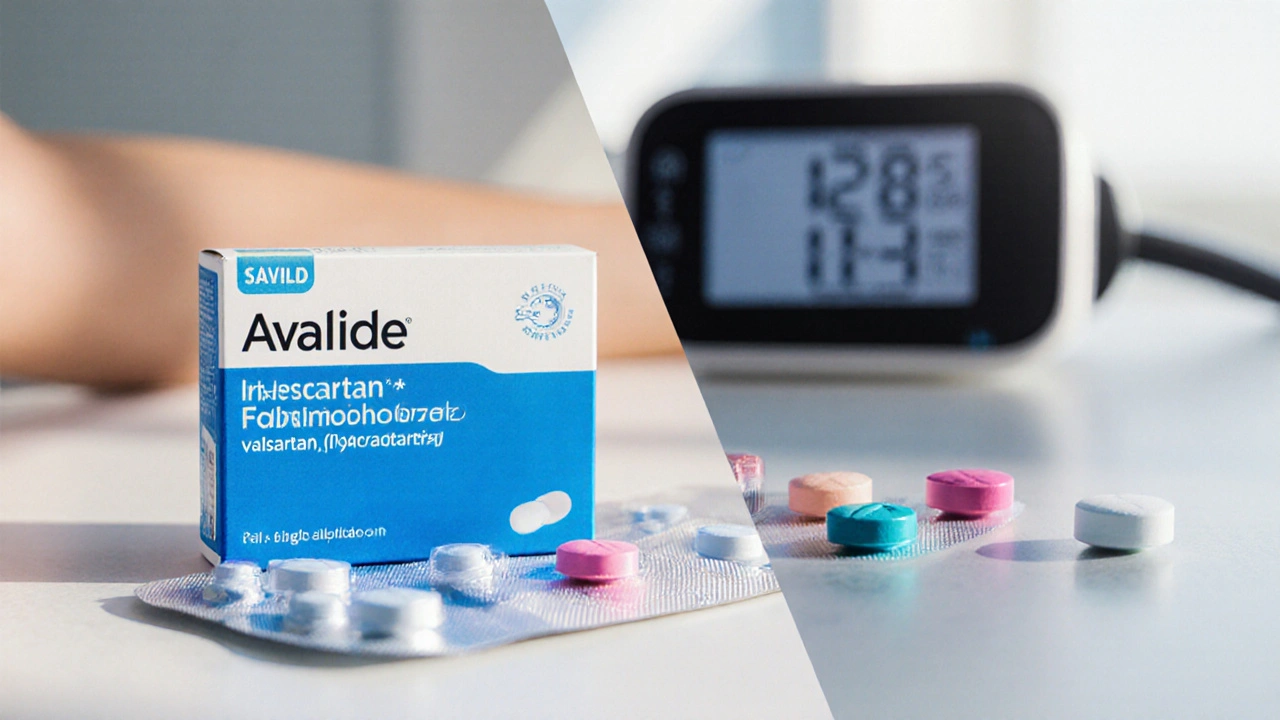Avalide vs ARB Alternatives Comparison Tool
About Avalide
Avalide combines irbesartan (ARB) with hydrochlorothiazide (diuretic) for dual blood pressure control. It offers convenience but may increase diuretic-related side effects.
Alternative ARBs
Single-ingredient ARBs include valsartan, losartan, olmesartan, and candesartan. These offer similar kidney protection but without diuretic side effects.
Side Effect Comparison
| Side Effect | Avalide | Valsartan | Losartan | Olmesartan | Candesartan |
|---|---|---|---|---|---|
| Dry Cough | Rare (ARB component) | Rare | Rare | Rare | Rare |
| Elevated Potassium | Possible (due to HCTZ effect) | Occasional | Occasional | Occasional | Occasional |
| Dizziness/Orthostatic Hypotension | More Common (diuretic) | Less Common | Less Common | Less Common | Less Common |
| Electrolyte Imbalance | Possible (HCTZ) | Unlikely | Unlikely | Unlikely | Unlikely |
| Kidney Function Impact | Neutral to Protective | Neutral | Neutral | Neutral | Neutral |
Cost Comparison (UK NHS List Price, 2025)
- Avalide 150mg/12.5mg £12.40
- Generic Irbesartan 150mg £4.20
- Separate HCTZ 12.5mg £2.10
- Valsartan 160mg £6.80
- Losartan 50mg £5.50
- Co-Diovan 50mg/12.5mg £9.30
Decision Matrix
- If you need both an ARB and a diuretic and prefer fewer pills → Avalide.
- If you're sensitive to thiazides (e.g., low potassium, gout, or diabetes) → a single-ingredient ARB plus a different diuretic or lifestyle measures.
- If cost is the primary driver → generic irbesartan with separate HCTZ, or switch to a cheaper ARB like valsartan.
- If you have a history of angio-edema with ACE inhibitors → any ARB is safe; choose based on side-effect tolerance.
- For patients with chronic kidney disease → all ARBs provide renal protection; pick the one with the most convenient dosing.
Interactive Decision Helper
Recommended Option:
Key Takeaways
- Avalide mixes irbesartan with hydrochlorothiazide for dual blood‑pressure control.
- Most alternatives are single‑ingredient ARBs (valsartan, losartan, olmesartan, candesartan).
- Avalide offers convenient dosing but may increase diuretic‑related side effects.
- Cost in the UK varies: generic irbesartan is cheap, while the combo can be pricier.
- Kidney protection is similar across ARBs; choose based on tolerance and pricing.
When treating high blood pressure, Avalide is a combined tablet that pairs irbesartan, an angiotensin‑II receptor blocker (ARB), with hydrochlorothiazide, a thiazide diuretic to lower systolic and diastolic readings in one pill. The combo aims to simplify regimens, but you might wonder how it stacks up against other ARBs that are taken alone.
Hypertension is a chronic condition where arterial pressure stays consistently above normal ranges and increases risk of heart attack, stroke, and kidney disease.
How Avalide Works
Irbesartan is an ARB that blocks the action of angiotensinII, a hormone that narrows blood vessels. By preventing this constriction, irbesartan relaxes arteries and reduces the workload on the heart. Hydrochlorothiazide is a thiazide diuretic that helps the kidneys excrete sodium and water, lowering blood volume. The two mechanisms complement each other, often achieving a greater drop in blood pressure than either component alone.
Typical dosing in the UK starts at 150mg irbesartan + 12.5mg hydrochlorothiazide once daily, with higher strengths (300mg/12.5mg or 300mg/25mg) available if needed. The drug reaches peak plasma levels within 2hours, and the half‑life of irbesartan (≈12hours) allows once‑daily dosing.

Common ARB Alternatives
The most frequently prescribed ARBs in Britain are:
- Valsartan (brand: Diovan) - a single‑ingredient ARB with a half‑life of about 6hours
- Losartan (brand: Cozaar) - the first ARB on the market, half‑life ~2hours, often combined with hydrochlorothiazide as Co‑Diovan
- Olmesartan (brand: Benicar) - long‑acting, half‑life up to 15hours, usually well tolerated
- Candesartan (brand: Atacand) - half‑life around 9hours, offering smooth 24‑hour control
Each of these drugs belongs to the ARB class, meaning they share the core ability to block angiotensinII. However, differences in pharmacokinetics, dose flexibility, and cost can tip the balance for individual patients.
Side‑Effect Profile: Avalide vs Single‑Ingredient ARBs
| Side‑effect | Avalide (IRB/HCTZ) | Valsartan | Losartan | Olmesartan | Candesartan |
|---|---|---|---|---|---|
| Dry cough | Rare (ARB component) | Rare | Rare | Rare | Rare |
| Elevated potassium | Possible (ARB) + diuretic effect may offset | Occasional | Occasional | Occasional | Occasional |
| Dizziness/orthostatic hypotension | More common (diuretic) | Less common | Less common | Less common | Less common |
| Electrolyte imbalance (low potassium) | Possible due to HCTZ | Unlikely | Unlikely | Unlikely | Unlikely |
| Kidney function impact | Neutral to protective | Neutral | Neutral | Neutral | Neutral |
Because Avalide adds a thiazide, patients may notice more frequent urination, mild low‑potassium levels, or a slight rise in blood‑sugar. Single‑ingredient ARBs avoid those diuretic‑related issues but require an extra pill if a diuretic is needed.

Cost and Availability in the UK
Pricing (NHS list price, 2025) per 28‑day supply:
- Avalide 150mg/12.5mg - £12.40
- Irbesartan generic 150mg - £4.20 (plus separate HCTZ 12.5mg - £2.10)
- Valsartan 160mg - £6.80
- Losartan 50mg - £5.50 (or Co‑Diovan 50mg/12.5mg - £9.30)
- Olmesartan 20mg - £7.10
- Candesartan 16mg - £6.00
If you’re already on a thiazide, the generic irbesartan + HCTZ combo can be cheaper than the branded Avalide. However, patients who dislike taking multiple tablets often accept the higher price for the convenience of a single pill.
Choosing the Right Option for You
Use the following decision matrix:
- If you need both an ARB and a diuretic and prefer fewer pills → Avalide.
- If you’re sensitive to thiazides (e.g., low potassium, gout, or diabetes) → a single‑ingredient ARB plus a different diuretic or lifestyle measures.
- If cost is the primary driver → generic irbesartan with separate HCTZ, or switch to a cheaper ARB like valsartan.
- If you have a history of angio‑edema with ACE inhibitors → any ARB is safe; choose based on side‑effect tolerance.
- For patients with chronic kidney disease → all ARBs provide renal protection; pick the one with the most convenient dosing.
Frequently Asked Questions
Can I switch from Avalide to a single‑ingredient ARB?
Yes. Your doctor can stop the combination and prescribe irbesartan alone, then add a separate thiazide if needed. The change usually happens over a week to monitor blood pressure and electrolytes.
Is Avalide safe during pregnancy?
No. Both irbesartan and hydrochlorothiazide belong to pregnancy‑category D. They can harm the fetus, so a different antihypertensive class is recommended.
What should I do if I experience low potassium while on Avalide?
Ask your GP for a potassium supplement or consider switching to an ARB without a thiazide. Blood tests every 2-4 weeks are standard after starting therapy.
How quickly does Avalide start working?
Blood‑pressure reduction can be seen within 2weeks, with the full effect reached after 4-6weeks of consistent dosing.
Are there any drug interactions I should watch for?
Avoid taking Avalide with other potassium‑sparing agents (e.g., spironolactone) or NSAIDs, as they can raise potassium or reduce kidney function. Also, high‑dose vitamin D supplements may increase calcium levels when combined with thiazides.
Talk to your GP or pharmacist to weigh the pros and cons based on your health profile, budget, and lifestyle. Whether you choose Avalide or a single‑ingredient ARB, consistent monitoring and adherence are the keys to keeping your blood pressure in check.

Zane Nelson
October 9, 2025 AT 18:23Upon perusing the comparative matrix delineated herein, one cannot help but observe the superficiality of the author’s approach to pharmacoeconomics. The discussion reduces a complex interplay of pharmacokinetics, patient adherence, and socioeconomic variables to a mere tabular juxtaposition. While the inclusion of cost metrics is commendable, the omission of long‑term cardiovascular outcomes betrays an elementary oversight. One would advise future renditions to integrate meta‑analytic data to elevate the discourse beyond cursory enumeration.
Sahithi Bhasyam
October 13, 2025 AT 05:43Wow, this guide is like a one‑stop shop for everything about Avalide and its cousins!!!, I love how it breaks down side‑effects, costs, and even the decision‑matrix-super helpful 💡, though I noticed a few little typos (like “irbesartan” spelt wrong in the cost table) 🤔, but overall great job, keep it up! 😊
mike putty
October 16, 2025 AT 17:03It's reassuring to know that both combo and single‑pill options can effectively manage blood pressure.
Kayla Reeves
October 20, 2025 AT 04:23The article glosses over the ethical implications of prescribing a pricier combo pill when a cheaper monotherapy exists, effectively prioritizing pharmaceutical profit over patient welfare. By neglecting to highlight the potential for medication non‑adherence due to cost, the piece inadvertently endorses a paternalistic model of care that many cannot afford.
Abhinanda Mallick
October 23, 2025 AT 15:43From a perspective that values rigorous scientific scrutiny, this comparison feels awash with complacent marketing jargon, dangerously obscuring the stark reality that British patients are being shepherded into costly brand‑name regimens. The narrative masquerades as neutral, yet subtly champions a profit‑driven agenda that undermines the sacred principle of equitable healthcare access. It is incumbent upon clinicians to dissect such superficial analyses with the fervor of a battle‑cry, lest we surrender to corporate influence.
Richard Wieland
October 27, 2025 AT 03:03While the side‑effect table is clear, patients should also consider individual comorbidities when selecting therapy.
rachel mamuad
October 30, 2025 AT 14:23The pharmacodynamic synergy between irbesartan and HCTZ is a classic example of antihypertensive co‑modulation, yet the paper fails to address the receptor‑level antagonism nuance which could impact renal perfusion in CKD cohorts. Also, the cost breakdown omitted the bulk‑discount pricing tier-something that pharmacy procurement officers would care about.
Amanda Anderson
November 3, 2025 AT 01:43Reading this felt like a roller‑coaster of hope and worry-hope for easier pill‑taking, worry about that dreaded dizziness that can knock you off your feet. The descriptions are vivid, and I could picture myself choosing Avalide just for the convenience, then hesitating over the side‑effect warnings.
Carys Jones
November 6, 2025 AT 13:03Despite the thoroughness, I remain skeptical of the implied superiority of single‑pill regimens; adherence is multifactorial and many patients thrive on multi‑tablet protocols that allow dose titration flexibility.
Roxanne Porter
November 10, 2025 AT 00:23The comparison does a solid job of laying out the key considerations, and I appreciate the balanced emphasis on both efficacy and economic factors. It serves as a useful reference for clinicians guiding shared decision‑making with patients.
Jonathan Mbulakey
November 13, 2025 AT 11:43When evaluating antihypertensive strategies, one must adopt a holistic lens that transcends mere cost and side‑effect tables. First, the pharmacokinetic profiles of irbesartan versus its counterparts dictate dosing frequencies and potential drug–drug interactions; irbesartan’s longer half‑life affords once‑daily administration, which can enhance adherence. Second, the inclusion of a thiazide diuretic introduces a cascade of physiological effects, ranging from natriuresis to alterations in calcium handling, which may be beneficial for patients with concomitant osteoporosis risk. Third, the socioeconomic dimension cannot be ignored-while the NHS list price provides a baseline, actual out‑of‑pocket expenses vary with prescription pre‑authorizations and supplementary insurance. Fourth, patient‑centered outcomes such as quality‑of‑life scores, reported dizziness, and laboratory electrolyte trends should inform therapeutic choices. Fifth, long‑term cardiovascular event data, especially from large‑scale outcome trials, remain the gold standard for discerning true clinical advantage; the guide’s omission of such data represents a notable gap. Sixth, clinicians must remain vigilant for contraindications, such as pregnancy, where both irbesartan and hydrochlorothiazide are classified as category D, mandating alternative agents. Seventh, the decision matrix could be enriched by incorporating patient preferences regarding pill burden, as some individuals prioritize simplicity over marginal cost savings. Eighth, the role of lifestyle modifications-dietary sodium reduction, exercise, and weight management-serves as an adjunct that can amplify pharmacologic effects regardless of the chosen agent. Ninth, genetic polymorphisms influencing the renin‑angiotensin system may predict differential responses to ARBs, an emerging field that future guidelines may integrate. Tenth, the potential for drug–drug interactions with common over‑the‑counter NSAIDs warrants caution, particularly concerning renal function. Eleventh, the impact on serum potassium is nuanced; while ARBs can raise potassium, the concomitant thiazide may counterbalance this effect, necessitating periodic monitoring. Twelfth, the side‑effect profile table, though helpful, would benefit from quantifying incidence rates based on real‑world evidence. Thirteenth, clinicians should be aware of the evolving regulatory landscape, which may affect drug availability and pricing. Fourteenth, shared decision‑making tools, such as the interactive helper embedded in the article, can empower patients but should be supplemented with personalized counseling. Fifteenth, the overarching principle remains that therapeutic choices must align with individual risk stratification, comorbidities, and patient values. In summary, while Avalide offers convenience, the decision to adopt it over single‑agent ARBs should be predicated on a comprehensive assessment that integrates pharmacologic, economic, and patient‑centric factors.
Warren Neufeld
November 16, 2025 AT 23:03Both options have their merits; discussing them with your doctor will help tailor the best plan for you.
Deborah Escobedo
November 20, 2025 AT 10:23Consider starting with generic irbesartan plus a separate low‑dose thiazide if cost is a concern; many patients find this regimen equally effective and it allows flexibility should side‑effects arise.
Dipankar Kumar Mitra
November 23, 2025 AT 21:43Honestly, the deep dive you just gave feels like a lecture from a textbook that nobody reads; most of us just want a clear, practical answer-does the combo actually improve my day‑to‑day life or just add another pill to the pile?
Tracy Daniels
November 27, 2025 AT 09:03Remember, the choice between Avalide and separate agents should hinge on your specific health profile-review your kidney function, electrolyte levels, and budget, then discuss these factors with your healthcare provider 😊.
Hoyt Dawes
November 30, 2025 AT 20:23This piece rehashes the same old comparison without offering any groundbreaking insight.